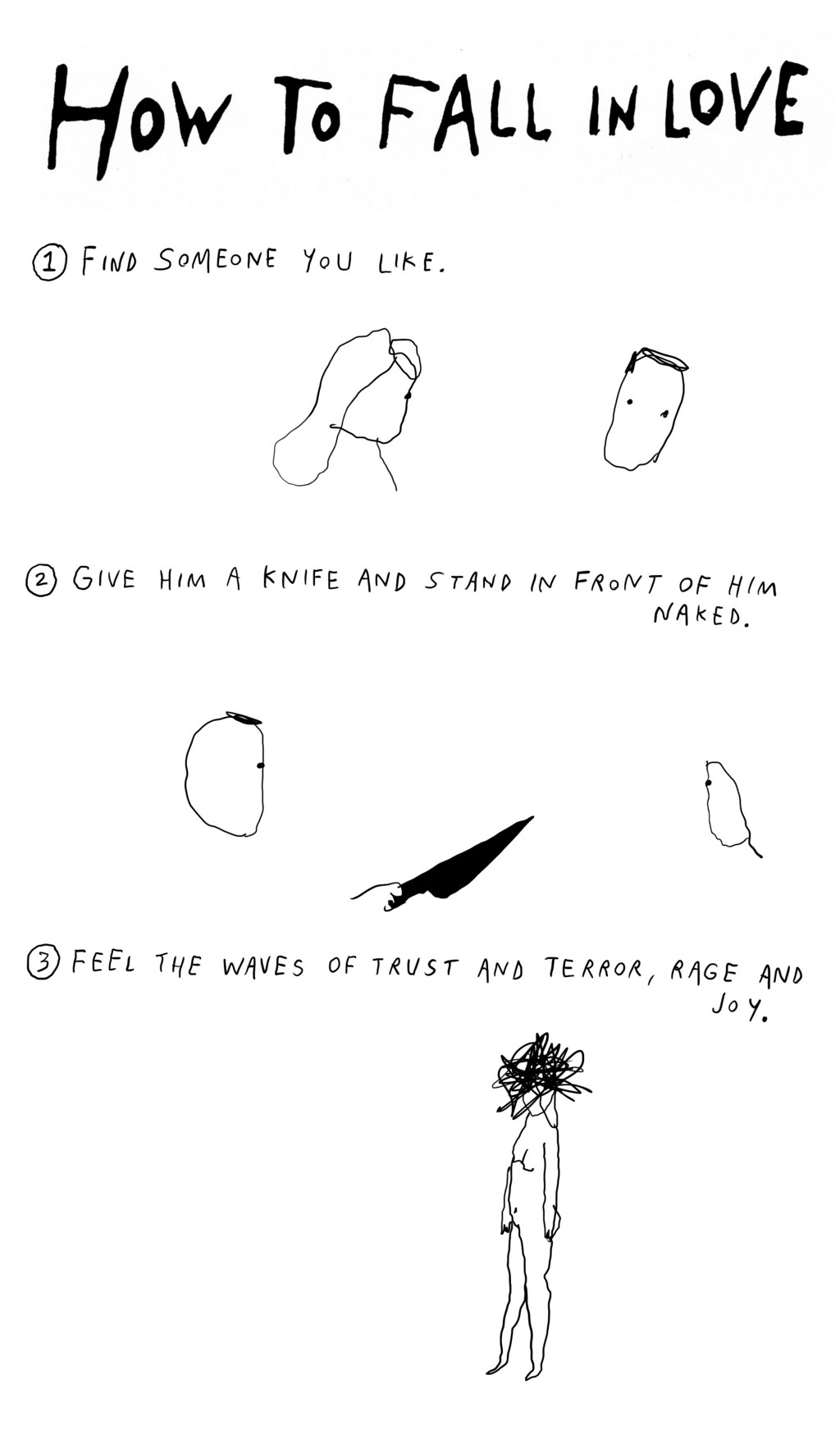New York City to Short Hills, New Jersey, to New York City, August 21, 2016

★★★ The air was heavy in the bedroom with the broken air conditioner, and outside noise had blared in through the window all night. Big piled-up white clouds sent dramatically contrasting patches of shade and brightness over the landscape. The highway was dry and clear. More clouds came, and the dimmed light brought out the blue in the blue-green growth of late summer. The breeze over the backyard swimming pool was chilly but the pavement was warm underfoot. The four-year-old had refused to wear his rashguard and eventually stood shivering as he struck a heroic pose with a borrowed water pistol. The nine-year-old had brought his wetsuit but his lips were turning blue anyway. Raindrops pecked at the windshield on the way back out through the winding roadways. A crowd poured out the gates of a waterside park and across the street, fleeing for their own cars. Rain slashed down on the highway, even as light blue lay ahead. In the city, under now-featureless skies, a shower was just starting, or starting again.
A Close Reading of Trader Joe's "Fearless Flyer"
Each entry is like an email from your mom.
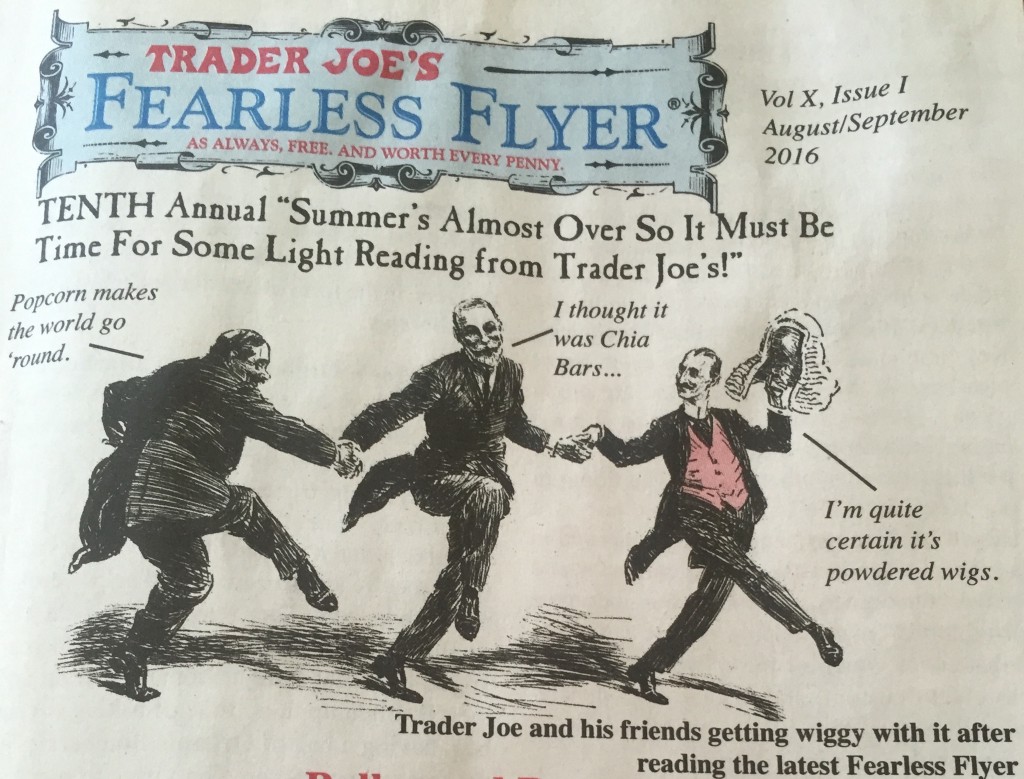
Anyone who lives in a big metropolitan area in a state that is not Alaska, Arkansas, Hawaii, Mississippi, Montana, North Dakota, West Virginia, or Wyoming has a Trader Joe’s somewhere within driving distance of them and has probably even been to it. Somehow, Trader Joe’s knows many of their addresses and sends out thousands and thousands of these three-color (blue, red, black) sixteen-page glue-bound pamphlets called “Trader Joe’s Fearless Flyer,” a bimonthly text-and-cartoon-only publication.
Vol X, Issue I arrived last week, per TJ’s explicit instructions, “Postmaster: Please deliver Tuesday August 16-Thursday August 18. The front cover (if we can call it that; is the same paper stock as the body pages) claims this is the TENTH Annual end-of-summer edition, which seems unbelievable, but there you have it. I know for a fact that none of you has ever had the pleasure of reading one of these things from cover to cover, and that is what I have just done. Mostly, it reminds me of radio commercials where they talk at great length about how juicy the grapes and steaks are. Herewith, a selection of highlights:
Bollywood Popcorn, $1.99 per 5 oz. bag
Right off the bat we have an unusual construction:
Following on the following for our Popcorn in a Pickle, we figured there was an appetite for popcorn flavors beyond simple cheese and caramel.

This could have been edited I suppose, but I’m slightly concerned the “following” rep was left on purpose, because ‘it’s punny’ (it’s not). No thank you, by the way, to dill pickle popcorn, but that’s just me. And personally I would have said “or” caramel, lest someone eat cheese AND caramel together, but given the ubiquity of those three-section gift tins, I’m going to wager it has happened before. But thank you for clarifying that there is no chicken in the popcorn (??).
Chicken Spring Rolls
How many times can you boldface the phrase Spring Rolls? The answer, at left, may surprise you.
Organic Blueberries
Trader Joe’s is making a pretty big assumption about my childhood and cultural upbringing by namechecking Violet Beauregarde, but I will allow it, because it’s correct; I just resent being so accurately nailed. TJ’s writes:
While her experience with the excesses of blueberries came from an inappropriate infatuation with chewing gum, Trader Joe’s delivers the big, bold, flavors of these azure orbs in their true form, from our freezers, in the form of Trader Joe’s Organic Blueberries.
I am not sure whether to call this “specious causality” or “a dangling modifier,” or just “two largely unrelated clauses,” but I know for sure the blueberry’s true form is not frozen. Also the form from the freezers in the form of is a lot of forms and froms. Azure orbs. Azure orbs.
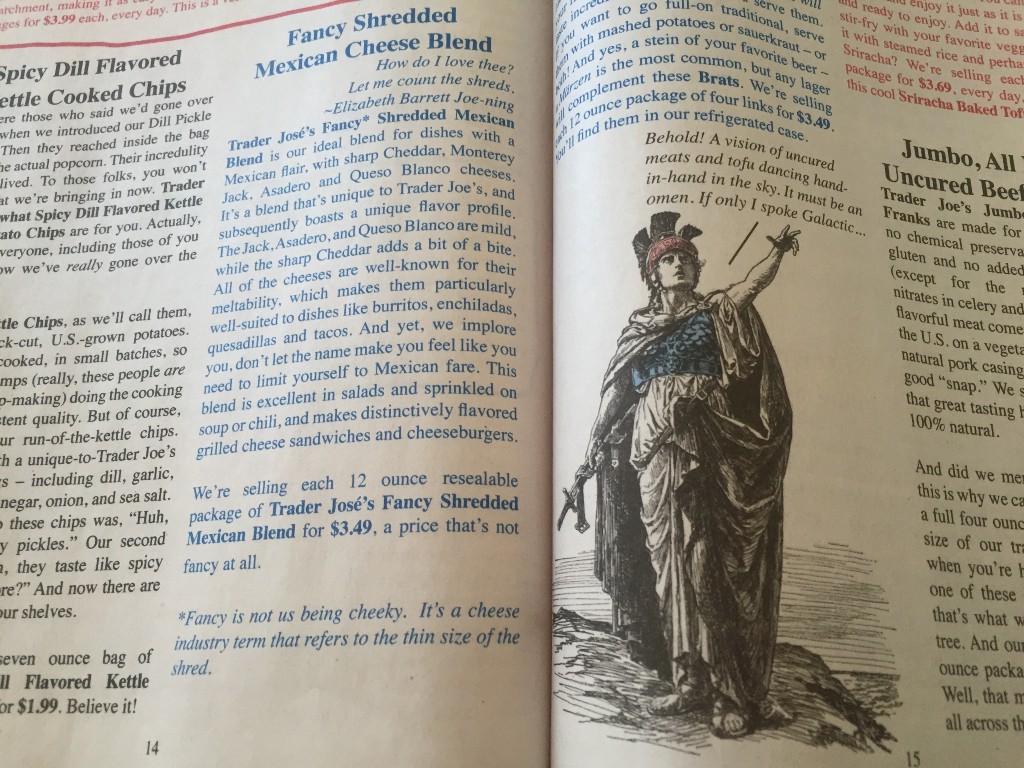
Fancy Shredded Mexican Cheese Blend
One of the most curious things about the Fearless Flyer is that it’s not as though it’s specifically highlighting seasonal products. Sure, it will give White Peaches (59 cents each) a summertime nod, but it will also feature things like baked beans, chia bars, and yes, shredded cheese. I’m conflicted about the listing for the Mexican Cheese Blend, because on the one hand it begins with a “quote” attributed to “Elizabeth Barrett Joe-ning” (👀), but it ends with an informative asterisk that tells the reader that the term “Fancy” is “a cheese industry term that refers to the thin size of the shred.” O-kaaaaaay but the rest of this entire pamphlet is you being cheeky, right?
Green is the New Black (this is an entry about green tea)
Okay SERIOUS question for tea people: is green tea pan-fried or pan-fired?
Vanilla Meringue Cookies
I love this entry because it lets you in on the behind-the-scenes Trader Joe’s vendor drama. The first hint of this is the subhead, which is just in regular body type: “Alternate headline for this article… They’re Baaaaack!” Why the ellipsis, you might ask? Why not, really.
To paraphrase: TJ’s had been selling the same meringues for like twenty years, until they “mysteriously disappeared.”
Well, it wasn’t actually so mysterious. Our vendor, the folks who’d been making them for us since the beginning, suddely decided to stop making these types of cookies. (If we could reveal their name, you’d really understand the irony of this decision.)
Spicy!!

Look, I’m not pointing any of this out because I think it’s embarrassing or bad necessarily, it’s more that I’m impressed that anyone would write two to three paragraphs about forty-eight featured items, ranging from Wasabi Mayonnaise to Unsweetened Almond Beverages to Chicken Breast in Water. And that makes me think, Oh God, someone was compelled to write up a lot of light, breezy, “accessibly voicey” copy about vanilla wafers. And the copy sounds a lot like emails my mom would write—for comparison (subject line: “Really tasty fire roasted tomatoes”):
I found these at Frontera tomatoes at Whole Foods. Browned 1 lb cut up chicken thighs, added chopped onion, the Frontera tomatoes, 1 bunch chopped fresh tuscan kale and some chicken broth. Let simmer 30–40 minutes. You can top with avocado for a nice, filling, home-cooked chipotle chicken dish.
Mom

Hand your mom a package of dark chocolate almonds and give her a keyboard and this is exactly what you’d end up with!! You can find some of this stuff online if you dig around hard enough, but I think it’s best enjoyed in its purest, recycled paper and soy-based ink form. You can also subscribe to an e-newsletter, but you know that’s just going to go directly to your promotions folder, and it’s just not the same tactile experience, you know?
And then suddenly I realize that the people who write the TJ’s brochures are not so different from those of us who slave away in the content mines (please like and share this post!). They gotta make content too! So pick up the flyer next time and give it a nice once-over. Maybe take it with you on the subway, and flaunt it like last week’s New Yorker. Just don’t tell anyone you read the cartoons first.
Our Lady of 'Truth or Dare'
Watching the Madonna documentary, twenty-five years later
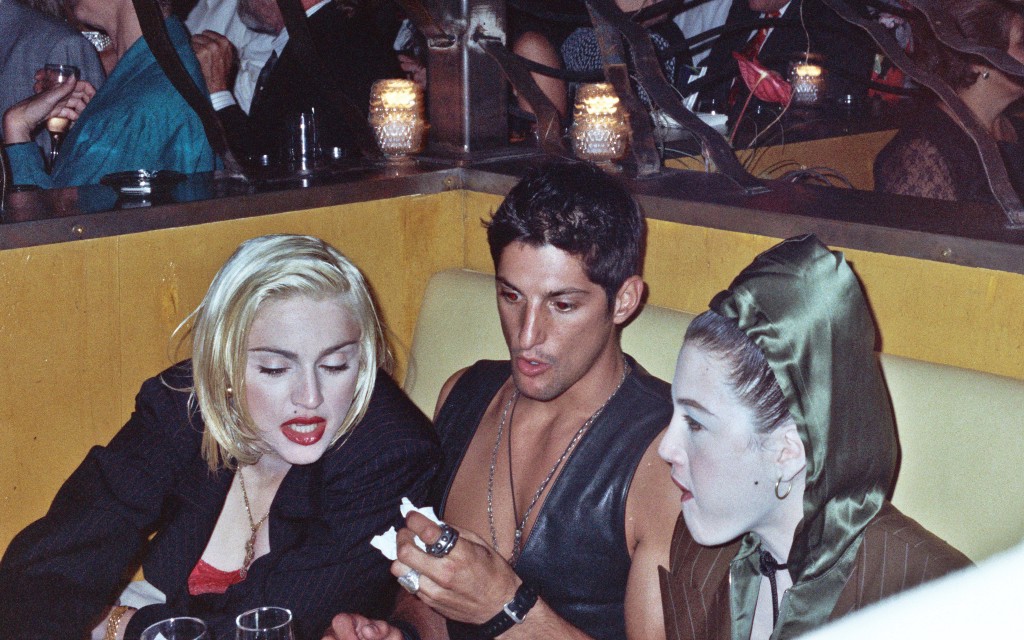
Madonna: Truth or Dare came out 25 years ago. Released to the most favorable reviews of her cinematic career, the film is about how Madonna lived her life on the Blonde Ambition tour. Arguably, Blonde Ambition was the apex of an era; the tour grossed $60 million, sold out every night except the cancelled date in shocked-and-Catholic Italy, and introduced the enduring image of the singer in a pink satin cone bra. In 1991 the public knew — and, more importantly, bought — what Madonna stood for: a sensual hunger for money; an obsession with black or latino Others that verged on problematique; the novelty of female sexuality; the exchange between strangers on the dance floor, under bridges, in booths; the fruits of risking it all for your artistic dreams; and hair, always hair. If one person embodied this much, did she ever get any sleep?
Outside of North America, the film was titled In Bed with Madonna, and that’s what we get, figuratively speaking. We see the bed that Madonna made, what she’d eventually call her erstwhile playground. From here you can draw a crooked line not just to nouveau pop stars in Madonna’s debt, but also the Kardashian-Wests and their in-laws, the Jenners, the Hadids — the entrepreneurs, for lack of a more exciting word, who build emotional and lucrative narratives around lips, eyebrows, dye jobs, weight loss, woo-woo spirituality, capital obsessions, love affairs, sex tapes, and, most of all, the white heat that comes from a person who knows what she wants. This is a movie about entitlement as much as it is about intimacy, fame, and beauty. From here we learn that entitlement suggests, but never confirms, that the person might know where she’s going. But does Madonna know where she’s going?
I like Truth or Dare because nothing really happens in it. There’s obviously a lot to talk about, but still: “Madonna does her job” is the log line. No one breaks up, no one dies, and no one quits the business. There’s Warren Beatty, Madonna’s beau of that moment, complaining that she never wants to have conversations off camera. There’s the ghost of David Fincher, who almost did the movie but bailed; by that point, he had directed three Madonna videos, including the similarly black-and-white “Vogue.” There’s Kevin Costner (!), calling the show “neat.” There’s the strung-out woman who shows up at a hotel and claims Madonna fingerbanged her when they were teens. There are the dancers who would later sue Madonna for misrepresenting them in this film, but there are also other dancers — beautiful, young, and yes, brown — with a type of joy in their queerness not often seen on film in those years. People drift in and out of a world that Madonna built, on the backs of a lot of people.
“Madonna does her job” is the log line.
I also love Truth or Dare because it’s weirdly warm. It’s a product of both an artist’s controlling nature and her instinct to let go a little bit, to be oblivious sometimes and a little wobbly. Her mic sometimes cuts out onstage; she’s sometimes tired, in her bathrobe, whining on the phone while slurping soup. And yet the film represents a career highlight with pride, without much discretion, but with some version of taste, like youthful nudes hung in the guest bathroom. The relationships between everyone on the tour seem more familial than most, and Madonna’s voiceover is beautiful, even when she complains. She knows how to confess. There is real melancholy, too — Madonna visits her mother’s grave, wondering about virtue; she says things about Sean Penn that make you sad for her, for them, for love. In hindsight, there’s also an element of “before the party ends” to the proceedings, before things get a little bit less queenly for the queen of pop.

On a lot of levels the film is fantasy, and one of those levels is political. Madonna’s choice to acknowledge Keith Haring’s death from AIDS in her show monologue, for example, is now ironic given the silence of three Blonde Ambition dancers living at that time with HIV. And the empowerment championed in “Express Yourself” is a little bit like a gift you know the giver wants mainly for herself. At this and every point in Madonna’s career, she is self-involved to the point of myopia, maybe blindness. When she picks “truth” in the eponymous game, someone asks her who the love of her life has been. “My whole life?” she asks at the age of 31, and she answers with tenderness: “Sean. Sean.” You know: a man who allegedly beat her with a baseball bat in Malibu.
When you watch Truth or Dare, it’s easy to catch up with what had already happened to the star, but try to wrap your head around what had yet to occur. There was so much left: Argentina, Antonio Banderas, Kabbalah, rays of light, Ali G and cowboy hats, Gwyneth Paltrow, macrobiotics, the absence of crying in baseball, the grace of Courtney Love, London accents (or something like them), a kiss with Britney Spears, a kiss with Christina Aguilera, many kisses with Rupert Everett, alleged alcoholism, a surprisingly fine James Bond theme, a forgotten song on an Austin Powers soundtrack, ABBA samples and deep squats on rollerskates, extremely misguided and semi-racist Instagrams, a performance at the Super Bowl with M.I.A., of all people, and a lot more of the same, a tireless kind of sturm und drang with less and less punch as Madonna’s brand of turbulence became the norm. No one can contest this woman’s endurance, and her relevance became moot — who cares? She really doesn’t.
One reason people hate Madonna, besides her long career of exploitation, is she tries so hard. Too hard, really, and for what these days? All of the above can be read as pointless desperation, and it often is. In the context Madonna established, it makes sense that an artist whose subject is both romantic and spiritual thirst would come on too strong, especially late in the game. But why does she still care so much? And why doesn’t it work anymore, beyond a crew of yes men and women who are determined to laugh at every joke and play every game?
One reason people hate Madonna, besides her long career of exploitation, is she tries so hard.
Let’s say that 1991-era Madonna is a blueprint for a type of person who is so famous that the initial product is besides the point. She’s an empire-builder, not always respected for her art, even though she is the only person to do it her way. If we follow this logic to its ultimate end, we must ask: Are the twilight years of such a person inevitably filled with hollow recreation? What will happen to Kanye West? Nothing terrible, one hopes. It’s not inherently bad to fade away, surrounded by your favorite things. But the meaning of the circus changes. Its vitality becomes way more foreboding.

In 1991, Madonna was a totem of the present. Now, Madonna is an icon of mortality. Even her hits about life make me think about life’s end. Remember how all the legends listed in “Vogue” are dead now? Or how about “Like a Prayer,” in which she insists that everyone ultimately must stand alone? On her last album, honest to God, one of the lyrics is “I want to die,” sung with plaintive pathos; I don’t think any other pop star makes me think about death so much. In the words of Madonna’s last truly great song, time goes by, so slowly. Especially for those who wait.
Think of it: Madonna was once a metonym for oversharing. In my favorite song of hers, “Burning Up,” she sings: “Unlike the others, I’d do anything.” She warned us from the beginning, really. From a book about sex — not just her sex life, but sex, as a concept — to paparazzi photos of her shopping for vibrators, this woman had no shame. Doesn’t it make sense then, that instead of a voice whispering, “Remember you must die,” Madonna’s memento mori is an oddly artsy, warmly told tell-all film? It’s her own voice, not a lackey’s, reminding her she’s just human, and it’s louder than you’d expect. It made it through the wilderness, one time too many. “Truth or dare?” the voice asks. And Madonna chooses both, always.
Madonna: Truth or Dare opens at The Metrograph on August 26 and runs through September 1.
Jen Vafidis is a writer. She has previously written for Rolling Stone, Gawker, The Awl, and Cosmopolitan.
Gawker, 2002-2016
For now it’s dead.

Each morning you wake to a new set of lies. They vary in subject and value and size. Some are omissions and some are direct, but the accretion of deceit contributes to a culture of cynicism and despair. Even knowing that you are being lied to is no help when everything around you is lies. You know that the positive reviews you read are written by writers who will not offer honest criticism for fear that it might hurt their future prospects. You know that no one is making the world a better place with an app that allows you to be chauffeured from a bar on one side of town to a bar on the other. You know that the people who are paid to tell you about your government regurgitate conventional wisdom to make themselves sound more authoritative. You know that you are being fed fear or hope or an idealized sense of yourself so that you will accede to their demands. Knowing you are being lied to is no help when everything around you is lies. All it does is habituate you to living with lies, so why would you bother to take anything too seriously? When words lose their meaning our very idea of what we owe each other is debased and devalued to such an extent that we become closed off and contemptuous and unable to rise above our own self-interest. We are afraid to diagnose deceit because we might be mocked for our innocence by those who tell us everyone already knows that these things are false, and so we stay silent. This situation has become so unremarkable that to make mention of it seems tiresome.
What Gawker did at its best was stand up and say, “No, you’re right, these are lies, you are correct to think that you are being lied to” and for however long that assertion hung there in the air you were able remind yourself that you weren’t wrong to feel discomfort with what whatever narrative they were pushing at you. You weren’t alone. It did not make the world better but at least it pressed pause on the world’s becoming worse. Gawker was not always, or even often, at its best. (See — or actually, please don’t — everything I wrote during my tenure there.) Gawker published a lot of garbage, and the strident defense of that garbage by the people who worked at Gawker was all the proof you need that everyone is captured in their own web of dishonesty eventually; Gawker’s biggest lies were the ones it told about itself. But these errors were small in scale when measured up against the pervasive duplicity offered by the other publications Gawker was established to counter. (It is no accident that many of the most heartfelt cheers for Gawker’s demise came from those in the press who had been stung by its appraisals; there is nothing more wounding to someone who has surrendered his critical faculties in exchange for admission to the system than to be reminded of his complicity in its fraudulence.) Gawker was stupid, loud, bullying and ill-informed, and most days it was the only honest thing you could read.
Now those days are over. We live in a world where we are lied to every day. The only rational response is outrage, but outrage is an emotion whose energy is impossible to sustain. Even the strongest among us eventually submit, and most of us are not strong. We have allowed people who don’t want to hear the truth — people who don’t want the truth to be told even when they know that it is rarely an impediment to their success — to silence those annoying, inconvenient voices that say “No, what you are telling us is not true.” Fewer questions will be asked, more falsehoods will pass unchecked, and we will wake up each morning to a new set of lies with a diminished capacity for remembering that we don’t have to accept them unconditionally or make peace with living in a world where they are the norm. Will the circumstances ever arise again where a site such as Gawker can come forward to challenge the dominant discourse of mendacity? Only a fool would venture to predict it. But we are each a little worse off without someone else to keep track of all the dishonesty and remind us that we are not crazy in those moments where we look around and rub our eyes and stare in shock at all the lies. Whether we know it or not, we are each a little worse off without Gawker in the world.
New York City, August 18, 2016

★★★ It was surprising, in the gray and tepid morning, to see how clear the air was: the buildings down Broadway flattening inton one another in the hazeless atmosphere. The subway was still hot and foul. Up on Fifth Avenue, young people in shorts with luggage were lined up at outdoor tables to check into their dorm and begin their future. When the time came to get up and go take a walk around the block, it was under more gray, the temperature numbly indeterminate. Some sun came on, indifferently at first and then richly. The light rattled along the top of the Astor, over details drawn and wrought by people now long dead.
Dear Twitter: Stop Trying To Make Check Marks Happen
Don’t verify me if I don’t ask to be verified!!!!!!!!

It happened to me yesterday—I was suddenly given a blue checkmark against my will. Congratulations to me, I was official. Officially what? Verified as me? You knew that already, Twitter, you have all my data and probably my fingerprints. It felt like I was I was fourteen, and my mom licked her hand and smoothed over my cowlick and shoved me onstage. Leave me alone, mom, I know I look like a slob—I look like a slob on purpose.
WHY HAVE I BEEN VERIFIED AGAINST MY WILL LIKE A FUCKING NERD
This is a presumptuous overstepping of boundaries. Some of us want to remain plainclothes civilians, that’s just more our speed. Other people wear the uniform really well, and that’s fine, let them have it. They look great.
The blue checkmark of verification used to mean something once, maybe. Mainly it seems to be useful for, like, celebrities and politicians—the kinds of people likely to have parody or fan accounts liable to be confused with their actual one. But why give them to journalists and media people? Maybe it’s a good idea for “engagement reporters” (a real job that is reporting with social media not on marriage engagements, alas), who are likely to contact people who’d otherwise be suspicious (“How do I know you’re really with the New York Times, eh?? Just because it says so in your bio?”).
But for the rest of us who reserve most of our tweeting for televised events we all watch together and complain about, a check mark doesn’t really do anything except make us look like we should know better. So please, Twitter: let me tweet dumb stuff if I want to without an unsolicited press pass.
As Choire wrote three years ago:
For me, the idea of verification taps deep issues about identity, about joining and belonging, and about status. I’d like to think I’d resist the allure of verification. What would be the point for me, beyond vanity? I have no impersonators. My Twitter does nothing of any importance; it’s for jokes and being dumb. But could I resist?
Twitter’s latest round of auto-verifications makes me wonder…Who on earth do they think I am? Are we all about to get sorted by some great quality controller? Yes, somewhat, and that’s probably a good thing:
New Ways to Control Your Experience on Twitter | Twitter Blogs
Turns out this feature was rolled out first to, wait for it, verified users. My favorite headline from yesterday’s news about the Quality Filter was from the Independent (God love the Brits for really telling it like it is): “Twitter adds ‘quality filter’ letting verified users switch off abuse.” Other articles called verified users ‘select people.’ On the one hand, I’m sort of turned off by that categorization, but on the other hand I’m glad Twitter is openly transparent about sorting its users rather than having some kind of internal code or designation for higher-tiered users.
I guess what I’m saying is it’s fine—not great—to sort us, but give me the option to opt out at least! If you had asked, I’d have said no. It’s annoying of me, I know, like those people who grow up in New York City and never get drivers’ licenses OR WORSE, never learn how to drive. I reserve the right to stay back here in economy class. It’s not worth the burden of people expecting more of me somehow because there’s a blue checkmark next to my name. I don’t need your approval, just my dad’s.
Pro tip: if you want to unverify after you get unwillingly verified, just protect your tweets and then un-protect them. Ha!
Rockaway Beach, New York

You stood so erect and stately-still behind your artisanal popsicle cart and its wonky little umbrella, that no one could not be struck by you. But, this being the boardwalk of Rockaway beach on a mid-August Saturday, no one was. Children screamed and threw down their toy buckets, bros in board shorts cheersed their plastic cups, a walnut-colored old white guy cruised past on a bicycle that blared out Barry Manilow. Big women in bikinis bustled into the Ladies and you, statue-perfect, continued to read your book. You held it as if ready to declaim from it, its front half folded back to facilitate an elegant clamping between thumb and forefinger in your upraised hand. The gesture evoked a costume of morning coat and monocle, or toga and garland, but you weren’t an Edwardian aristocrat or a Roman orator, but a cute brown girl with baby blonde curls in a pretty sun dress. It became very important for me to know what you were reading.
My friend and I were slumped against the baking wall of the Ladies, bags at our feet, staring at you with salty sore eyes, deep in a sun-stupor after five hours on the beach. We shifted about in our damp shorts, feeling the sand abrade incipient sunburns, and waited for our men to emerge from the Mens. I kept squinting at you and your book, marvelling that your eyes never left it. My friend, however, was more interested in your popsicles. She returned with a piña colada flavored one and offered me a bite. Through teeth full of frozen coconut milk I asked her what you were reading.
“The Limits of Logic.”
“Did you ask?!” I asked, excited.
“I saw,” she said, implacable. (My friend is Russian.)
The Limits of Logic! What were they! It was just not logical to me that you should be reading such a book. That you should be on this boardwalk selling popsicles in the Saturday sunshine in your cute dress while reading a book with a title as arid as The Limits of Logic seemed, in fact, to push the limits of logic. Being a romantic rather than logical sort, I’d hoped you might be reading something like Middlemarch, proud and perfect in your solitude, high-minded as Dorothea. But I kept turning the title over in my head and here’s the foolish fantasy that crept in: maybe The Limits of Logic was not the dry, mathematical treatise I’d assumed, but in fact a refutation of mathematics, a book about all that was beyond logic — the many inexplicable and mystical phenomena which exceeded logic’s limits. That maybe your mind was being blown while you stood there above the piña colada popsicles. This, I knew, as my friend beside me sucked her popsicle stick dry, was not logical.
Keepin' it Real
Behind the scenes with actual pro wrestling referees
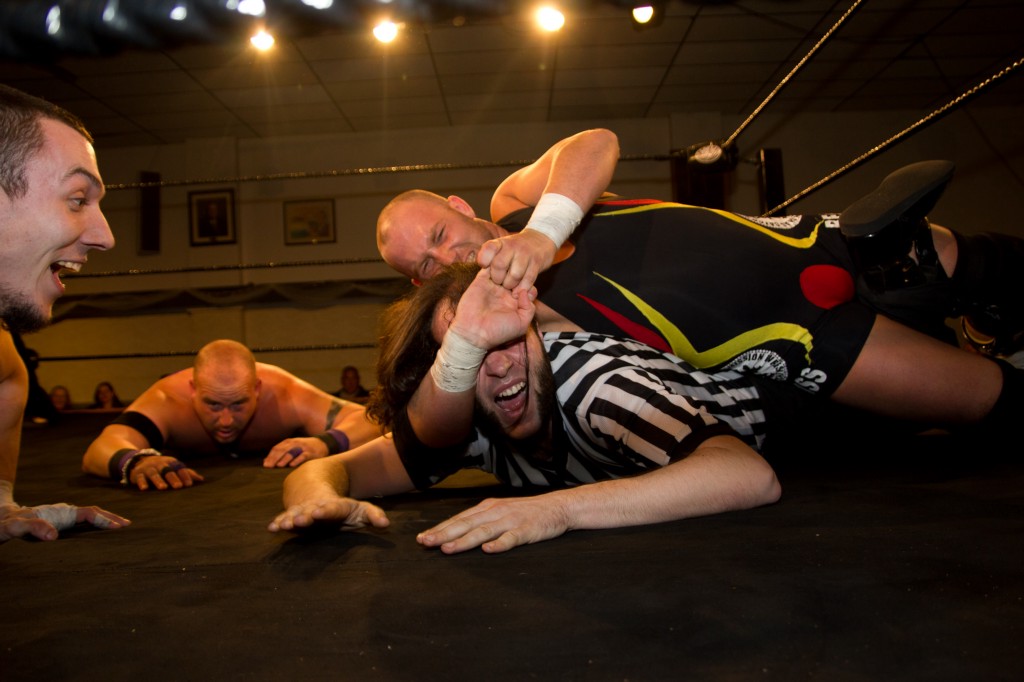
The professional wrestling referee is as much a product of his outlandish environment as bacne and bloodshed. Like pro wrestling itself, they are perpetually torn between striving for legitimacy and twisting towards theatrical entertainment. The result is some illogical combination between a baseball umpire and a rodeo clown. After all, pro wrestling is about as conflicted as a tag team grappler debating whether or not to double-cross his partner.
Wrestlers are incredibly athletic and their craft is challenging and dangerous, but the outcomes are predetermined. The storylines are ludicrously over-the-top, but grudges are settled in officiated matches that aspire to resemble the regulated, rule-based world of traditional sports.
It’s fake, but it’s real. Or it’s real, but it’s fake. And the referee is the crux of that wonderful confusion. The refs I spoke with described surreal, alternately grim and hilarious occasions on which show business awkwardly collided with a less glamorous reality: choreographed moves resulting in very serious injuries, off-script in-ring brawls, and wrestlers performing under a spotlight in front of thousands somehow concealing full-length conversations about post-match drinks.
It’s fake, but it’s real. Or it’s real, but it’s fake.
The latter happened to Brian Hebner, who recalled working his first match with Hulk Hogan. Brian, a successful referee who’s worked for World Wrestling Entertainment (WWE) and Total Nonstop Action Wrestling (TNA), is also the son of the most famous ref in pro wrestling history, Earl Hebner.
“I’m in the ring with [Hogan] and just the conversation that he had with me was like mind-boggling because I never had anyone just like sit there and have a conversation while we were working,” said Brian. “And you have to remember at the same time I was scared as shit because I was working with Hogan for my first time — last thing you want to do is screw up. But I couldn’t even focus on my job because he was talking to me.”
What topic of conversation was urgent enough for Hogan to pursue mid-match — proper tanning techniques? Fu Manchu maintenance tips? It turned out Hulk was just asking Brian if he was as good of a ref or drinker as his father Earl. Brian answered, “Yes, sir.”
“[Hogan] said, ‘Well, after this match,’ — he was in a hold when I was doing this, he was in an actual, physical hold — and he says, ‘Well right after I drop the boot, right after I hit him with the boot and the leg, son, we’re out of here. We’ll go drink some cold beers.’”

It’s difficult to imagine a similar interaction between, say, Tom Brady and famed NFL official Ed Hochuli. But to the casual observer, wrestling referees are to sports officiating what Judge Judy is to the Supreme Court. I asked Thomas Kearins, an official for Insane Championship Wrestling (ICW, a Scotland-based organization and one of a multitude of regional, independent wrestling groups), about the biggest misconception regarding pro wrestling officials. Kearins replied, “Probably that we’re all idiots.”
Wrestling referees are usually depicted as fools — commonly tricked by cheating wrestlers, they are chronically incapable of preserving order. Yet, referees are integral to both the drama and mechanics that go into crafting a (relatively) safe, exciting product. When wrestling wants to be on ESPN, the refs lend an air of authenticity. When wrestling wants to be on E!, the refs add to the staged melodrama.
Even the most passionate wrestling fans are often unaware of the actual responsibilities of referees, taking their bumbling on-screen roles for granted. In major organizations like the WWE and TNA, referees wear earpieces so they can subtly relay information from backstage to the wrestlers, like stagehands hidden in plain sight. Brian Hebner described the frenzied communication system through which he received constant input from the production truck, backstage agents, and writers, as “very annoying” and “pretty hectic.” Understandable, when you consider he must simultaneously perform a completely separate on-screen role.
referees wear earpieces so they can subtly relay information from backstage to the wrestlers
Hebner explained that referees get feedback from backstage if the match isn’t going as planned or if the crowd isn’t reacting as hoped. During TV broadcasts the referee also needs to discreetly help the wrestlers build a match perfectly suited to commercial breaks.
“I count them down to the commercial break and if they’re not where they need to be, I’ll tell them what they need to do to get to somewhere to where we can go on the break,” said Hebner, who needs to accomplish this without the audience noticing. In the tradition of any good TV drama, the key is leaving for commercial at an exciting high point and returning with something unexpected, using the commentary team and replays to fill viewers in on what they missed. The final product is intended to appear spontaneous and unrehearsed, but, of course, that’s only partially the case.

Perhaps the efforts of these men (and they are almost always men) are widely misunderstood because their role is so contradictory. Traditional sports fans have a hard time wrapping their minds around officials who are scripted into the competition. Though wrestling refs attempt to uphold the rules and dress like Foot Locker employees, they also get involved in the action itself.
Pro wrestling takes the myopic ref cliché to new heights — these guys don’t just miss calls, they get distracted by a scantily clad starlet’s cleavage or accidentally get knocked unconscious. It’s a clever satire of sports with a strategic twist: their incompetence is intended to make villains more dastardly and heroic comebacks more valorous.
“You got to think of it like your days in high school,” explained independent referee Dan Tanaka. “The rebellious kids, when the teacher’s back is turned, that’s when they start doing stuff they’re not supposed to be doing, but when the teacher turns back around they stop doing it, they’re back to where they’re supposed to be.” It’s a simple trick that has been consistently riling up crowds for decades. But if overdone, it can ruin the credibility of the referees and actually damage the match.
“It just has to be done in a way that’s not going be burying myself to make myself look stupid,” said Brian Hebner. Essentially, if the crowd’s reaction (called “heat”) transitions from the cheating wrestlers to the incompetent referee, the match suffers. “[The wrestlers are] the ones that want the heat from the fans, not me,” said Hebner. “So if they make me look stupid, then all the fans are going to be pissed at me because they’re going to be like, ‘You dumbass, turn around.’”
if the crowd’s reaction (called “heat”) transitions from the cheating wrestlers to the incompetent referee, the match suffers.
Of course, safety is paramount. “You’ll often see me have a wrestler stand across the ring while I check on their opponent after a particularly hard-hitting move that I’ve noticed might’ve rocked them a little bit,” Kearins explained. “What I do is gauge whether or not to call the match off and let the medical professionals handle it or continue to the finish.”
Policing injuries in a never-say-die culture of tattooed warriors isn’t an easy task and can be a shoot-the-messenger situation. Consider: Dodgers ace pitcher Clayton Kershaw is likely to understand the long-term logic of exiting a game early when his troublesome back acts up. But, you try explaining that to notorious hardcore wrestler Abdullah the Butcher.

A few levels removed from sleek TV programming and glossy professionalism, independent wrestling brings an entirely different set of challenges. If the WWE is wrestling’s Coca-Cola, there are plenty of RC Colas and Faygos dotting the national landscape. These obscure, regional organizations run shows for smaller crowds in high school gymnasiums and other smaller venues.
Referees in independent organizations often have to take on additional duties, like helping set up the ring before the show and pack it up afterwards. And, like a DIY punk show, both the crowds and performers tend to be rougher around the edges. Tanaka described an independent show in which the wrestlers veered off-script and got into an actual brawl, and Kearins said, “I once had to try and make it to a particular guy in the crowd that had thrown a drink in the ring before five well-known heavyweights got to him first at a show I did in London. I’m afraid I didn’t make it in time but at least he now knows not to throw things, I guess.”
Like the difference between a Disney World roller coaster and the rickety Zipper at the local fair, the separation between theatrical conflict and real danger is even thinner at independent shows. Once, Tanaka officiated a main event for an independent organization featuring former WWE sideshow spectacle The Boogeyman, a notoriously bizarre character who once met Donald Trump.
the separation between theatrical conflict and real danger is even thinner at independent shows
Tanaka awarded the match, a championship bout, to The Boogeyman via disqualification. But it was a hollow victory — a challenger can only win a title by pinning his opponent or forcing him to submit.
“The Boogeyman — he’s upset, he’s upset — turns to me as I’m still dazed and picks me up for his BoogeyBomb, which is a double-handle chokeslam,” the five-foot-six, 150-pound Tanaka told me. “I wasn’t ready and I ended up getting a minor concussion.” It gets worse, and weirder.
“But then of course he was going for The Worms,” continued Tanaka, “and the fans were like, ‘No, no, don’t give him The Worms, he’s innocent, he didn’t know what was going on.’”
“The Worms?” I asked Tanaka, naively hoping it was the name of some sort of slithering-based submission hold.
“After [The Boogeyman] defeated his opponents, he gets this bag out that was full of earthworms and he’d put it in his mouth and drop it in his opponent’s mouth or all over their face,” Tanaka matter-of-factly explained. “He had me sitting up, ready for The Worms, and the fans were like, ‘No, no, don’t do it, don’t do it’…I was like ‘Oh, thank God.’”
Yes, the worms — just another on-the-job hazard for your local pro wrestling referee. “The worms get rinsed off under a sink to get all of the dirt off of them,” said Tanaka. “The promoter had to go buy them out from a bait shop and get them rinsed off and ready for him.”
Ted Pillow writes.
Fiona Brice, "Berlin" (Donato Dozzy Montecirceo Remix)
I bet you’re ready for some weekend, huh?

Ah, the weekend. Since the dawn of the week man has yearned for its beautiful embrace. Soon — so soon that the glands in your tongue are salivating over its sweet flavor and every time you close your eyes you see its alluring figure beckon you toward it — you will find yourself inside the weekend, and then every care that weighed you down over the last five days will seem weightless and transparent and in no way worth the worry that you wasted when considering how they would work out. Then of course the weekend will leave you in your sleep and you will be confronted once again with the sheer inescapable horror that is your life. But that will come later. Right now let us anticipate the weekend. Press play, close your eyes and enjoy, it is almost here.

